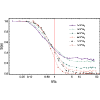Enhanced Extreme Mass Ratio Inspiral Rates and Intermediate Mass Black Holes
IF 8.1
1区 物理与天体物理
Q1 PHYSICS, MULTIDISCIPLINARY
引用次数: 0
Abstract
Extreme mass ratio inspirals (EMRIs) occur when stellar-mass compact objects begin a gravitational wave (GW) driven inspiral into massive black holes. EMRI waveforms can precisely map the surrounding spacetime, making them a key target for future space-based GW interferometers such as LISA, but their event rates and parameters are massively uncertain. One of the largest uncertainties is the ratio of true EMRIs (which spend at least thousands of orbits in the LISA band) and direct plunges, which are in-band for at most a handful of orbits and are not detectable in practice. In this Letter, we show that the traditional dichotomy between EMRIs and plunges—EMRIs originate from small semimajor axes, plunges from large—does not hold for intermediate-mass black holes with masses . In this low-mass regime, a plunge always has an probability of failing and transitioning into a novel “cliffhanger” EMRI. Cliffhanger EMRIs are more easily produced for larger stellar-mass compact objects, and are less likely for smaller ones. This new EMRI production channel can dominate volumetric EMRI rates if intermediate-mass black holes are common in dwarf galactic nuclei, potentially increasing by an order of magnitude.

增强的极端质量比漩涡速率和中等质量黑洞
当恒星质量的紧凑天体开始在引力波(GW)的驱动下吸入大质量黑洞时,就会发生极端质量比吸积(EMRI)。EMRI 波形可以精确映射周围的时空,因此成为未来天基引力波干涉仪(如 LISA)的关键目标,但其事件发生率和参数具有极大的不确定性。最大的不确定性之一是真正的 EMRI(在 LISA 波段内至少运行数千个轨道)和直接暴跌的比例,后者在波段内最多运行几个轨道,实际上是探测不到的。在这封信中,我们证明了 EMRI 和暴跌之间的传统二分法--EMRI 来自小半长轴,暴跌来自大半长轴--对于质量为 M-≲105M⊙ 的中等质量黑洞来说并不成立。在这一低质量体系中,暴跌总是以 O(1)的概率失败并过渡到新的 "悬崖 "EMRI。较大恒星质量的紧凑型天体更容易产生 "悬崖 "EMRI,而较小的天体则不太可能。如果矮星系核中普遍存在中等质量的黑洞,那么这种新的EMRI产生渠道可能会主导体积EMRI速率n˙EMRI,从而可能使n˙EMRI增加一个数量级。
本文章由计算机程序翻译,如有差异,请以英文原文为准。
求助全文
约1分钟内获得全文
求助全文
来源期刊

Physical review letters
物理-物理:综合
CiteScore
16.50
自引率
7.00%
发文量
2673
审稿时长
2.2 months
期刊介绍:
Physical review letters(PRL)covers the full range of applied, fundamental, and interdisciplinary physics research topics:
General physics, including statistical and quantum mechanics and quantum information
Gravitation, astrophysics, and cosmology
Elementary particles and fields
Nuclear physics
Atomic, molecular, and optical physics
Nonlinear dynamics, fluid dynamics, and classical optics
Plasma and beam physics
Condensed matter and materials physics
Polymers, soft matter, biological, climate and interdisciplinary physics, including networks
 求助内容:
求助内容: 应助结果提醒方式:
应助结果提醒方式:


